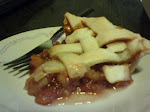
Cranberries are harvested in the fall when the fruit takes on its distinctive
deep red color. This is usually in late September or early October. To harvest cranberries, the beds are flooded with six to eight inches of water above the vines. A harvester is driven through the beds to remove the fruit. For the past 50 years, water reel type harvesters have been used. Harvested cranberries float in the water and can be corralled into a corner of the bed. From the farm, cranberries are t

aken to receiving stations where they are cleaned, sorted and stored prior to packaging or processing. Although most cranberries are wet-picked as described above, 5-10% of the US crop is still dry-picked. This entails higher labor costs and lower yield, but dry-picked berries are less bruised and can be sold as fresh fruit instead of having to be immediately frozen or processed. White cranberry juice is made from regular cranberries that have been harvested after the fruits are mature but before they have attained their characteristic dark red color. About 95% of cranberries are processed into products such as juice drinks, sauce and sweetened dried cranberries. The remaining 5% are sold fresh to consumers. Cranberry juice is a major use of cranberries; it is usually either sweetened to make "cranberry juice cocktail" or blended with other fruit juices to reduce its natural severe tartness. Usually cranberries as fruit are cooked into a jelly, known as cranberry sauce. Thanksgiving Dinner would not be complete without it. ~ Chef Wilkinson ~

 Cranberries are harvested in the fall when the fruit takes on its distinctive deep red color. This is usually in late September or early October. To harvest cranberries, the beds are flooded with six to eight inches of water above the vines. A harvester is driven through the beds to remove the fruit. For the past 50 years, water reel type harvesters have been used. Harvested cranberries float in the water and can be corralled into a corner of the bed. From the farm, cranberries are t
Cranberries are harvested in the fall when the fruit takes on its distinctive deep red color. This is usually in late September or early October. To harvest cranberries, the beds are flooded with six to eight inches of water above the vines. A harvester is driven through the beds to remove the fruit. For the past 50 years, water reel type harvesters have been used. Harvested cranberries float in the water and can be corralled into a corner of the bed. From the farm, cranberries are t aken to receiving stations where they are cleaned, sorted and stored prior to packaging or processing. Although most cranberries are wet-picked as described above, 5-10% of the US crop is still dry-picked. This entails higher labor costs and lower yield, but dry-picked berries are less bruised and can be sold as fresh fruit instead of having to be immediately frozen or processed. White cranberry juice is made from regular cranberries that have been harvested after the fruits are mature but before they have attained their characteristic dark red color. About 95% of cranberries are processed into products such as juice drinks, sauce and sweetened dried cranberries. The remaining 5% are sold fresh to consumers. Cranberry juice is a major use of cranberries; it is usually either sweetened to make "cranberry juice cocktail" or blended with other fruit juices to reduce its natural severe tartness. Usually cranberries as fruit are cooked into a jelly, known as cranberry sauce. Thanksgiving Dinner would not be complete without it. ~ Chef Wilkinson ~
aken to receiving stations where they are cleaned, sorted and stored prior to packaging or processing. Although most cranberries are wet-picked as described above, 5-10% of the US crop is still dry-picked. This entails higher labor costs and lower yield, but dry-picked berries are less bruised and can be sold as fresh fruit instead of having to be immediately frozen or processed. White cranberry juice is made from regular cranberries that have been harvested after the fruits are mature but before they have attained their characteristic dark red color. About 95% of cranberries are processed into products such as juice drinks, sauce and sweetened dried cranberries. The remaining 5% are sold fresh to consumers. Cranberry juice is a major use of cranberries; it is usually either sweetened to make "cranberry juice cocktail" or blended with other fruit juices to reduce its natural severe tartness. Usually cranberries as fruit are cooked into a jelly, known as cranberry sauce. Thanksgiving Dinner would not be complete without it. ~ Chef Wilkinson ~










































